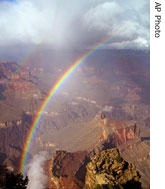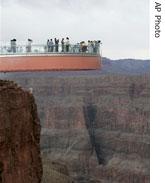-
(单词翻译:双击或拖选)
VOICE ONE:
I'm Steve Ember.
VOICE TWO:
And I'm Barbara Klein with Explorations in VOA Special English.
| A tribe member looks at the new Grand Canyon West Skywalk built by the Hualapai Indians. Critics say it harms the natural beauty of the canyon. |
(MUSIC)
VOICE ONE:
The canyons3 of America's Southwest are deep, ancient openings in the earth. They look as if they formed as the earth split4 apart. But the canyons did not split. They were cut by rivers.
The rivers carried dirt and pieces of stone that slowly ate away at the surrounding rock. For millions of years, the rivers turned and pushed. They cut deeper and deeper into the earth. They left a pathway of great rocky openings in the earth that extend for hundreds of kilometers.
VOICE TWO:
The Grand Canyon in Arizona is one of the largest and most beautiful of all canyons. It extends four hundred fifty kilometers.
The surrounding area does not make you suspect the existence of such a great opening in the earth. You come upon the canyon suddenly, when you reach its edge. Then you are looking at a land like nothing else in the world.
VOICE ONE:
Walls of rock fall away sharply5 at your feet. In some places, the canyon walls are more than a kilometer deep. Far below is the dark, turning line of the Colorado River.
 |
| Two rainbows form at Hopi Point at Grand Canyon National Park in Arizona |
On the other side, sunshine lights up the naked rock walls in red, orange, and gold. The bright colors are the result of minerals in the rocks. Their appearance changes endlessly -- with the light, the time of year, and the weather. At sunset, when the sun has moved across the sky, the canyon walls give up their fiery6 reds and golds. They take on quieter colors of blue, purple, and green.
VOICE TWO:
Hundreds of rocky points rise from the bottom of the Grand Canyon. Some are very tall. Yet all are below the level of an observer on the edge, looking over.
Looking at the Grand Canyon is like looking back in time. Forty million years ago, the Colorado River began cutting through the area. At the same time, the surrounding land was pushed up by forces deep within the Earth. Rain, snow, ice, wind, and plant roots rubbed away at the top of the new canyon. Below, the flowing river continued to uncover more and more levels of ancient rock.
Some of Earth's oldest rocks are seen here. There are many levels of granite7, schist, limestone8, and sandstone.
VOICE ONE:
The Grand Canyon has several weather environments. The top is often much different from the bottom. On some winter days, for example, you may find cold winds and snow at the top. But at the bottom, you may find warm winds and flowers.
Several kinds of plants and animals are found in the canyon and nowhere else on Earth. Because the canyon's environments are so different, these species9 did not spread beyond the canyon, or even far within it.
(MUSIC)
VOICE TWO:
Native American Indians occupied the Grand Canyon three thousand years ago. Evidence of their existence has been found in more than two thousand five hundred places so far. Bones, hair, feathers, even the remains10 of plants have been found in deep, dry caves high in the rock walls.
The Hopi, the Paiute, the Navajo and other Native American tribes11 have all been in the area for at least seven centuries. However, much of what we know today about the Grand Canyon was recorded by John Wesley Powell. In eighteen sixty-nine, he became the first white American to explore much of the canyon.
VOICE ONE:
John Wesley Powell and his group traveled in four boats. They knew very little about getting over the rapid, rocky waters of the Colorado River. In many areas of fast-flowing water, a boat could be turned over by a wave as high as a house.
Soon after starting, Powell's group lost some of its food and equipment. Then three members of the group left. As they walked up and out of the canyon, they were killed by Indians. The rest of the group was lucky to survive. Starving and tired, they reached the end of the canyon. They had traveled on the Colorado River for more than three months.
John Wesley Powell's reports and maps from the trip made him famous. They also greatly increased interest in the Grand Canyon. But visitors did not begin to go to there in large numbers until nineteen-oh-one. That was when a railroad reached the area.
(MUSIC)
VOICE TWO:
Today, the Grand Canyon is known as one of the seven wonders of the natural world. About five million people visit the canyon each year. Most visitors walk along paths part way down into the canyon. It takes several hours to walk to the bottom. It takes two times as long to get back up. Some visitors ride mules12 to the bottom and back. The mules are strong animals that look like horses. They are known for their ability to walk slowly and safely on the paths.
America's National Park Service is responsible for protecting the Grand Canyon from the effects of so many visitors. All waste material must be carried out of the canyon. All rocks, historical objects, plants, and wildlife must be left untouched. As the National Park Service tells visitors: "Take only photographs. Leave only footprints. "
VOICE ONE:
There are several other ways to visit the Grand Canyon. Hundreds of thousands of people see the canyon by air each year. They pay a helicopter or airplane pilot to fly them above and around the canyon.
About twenty thousand people a year see the Grand Canyon from the Colorado River itself. They ride boats over the rapid, rocky water. These trips last from one week to three weeks.
VOICE TWO:
 |
| The Skywalk is on the Hualapai Indian Reservation |
The Hualapai Indian Tribe built the Skywalk at a cost of more than forty million dollars. The tribe owns almost four hundred thousand hectares of land in the canyon. The Hualapai built the Skywalk to gain money by getting more people to visit its reservation. The tribe says the area, called Grand Canyon West, will include a large visitors' center, restaurants, and possibly hotels in the future.
| Among the first guests on the Skywalk were former astronauts Buzz Aldrin and John Bennett Herrington, a Native American |
(MUSIC)
VOICE ONE:
Many writers have tried to describe the wonder of the Grand Canyon. They use words like mysterious, overpowering, strange. Yet writers recognize that it is impossible to put human meaning in such a place. The Grand Canyon exists in its own space and time.
Some visitors say they feel so small when measured against the canyon's great size. One writer who has spent a lot of time in the Grand Canyon finds it a peaceful place. He says the almost overpowering silence and deepness of the Grand Canyon shakes people -- at least briefly16 -- out of their self-importance. He says it makes us remember our place in the natural world.
VOICE TWO:
We close our program with music from a record called "Canyon Lullaby" written by Paul Winter. Mister Winter said it was his first attempt to translate the spirit of the canyon into sound.
(MUSIC)
VOICE ONE:
This program was written by Shelley Gollust. It was produced by Mario Ritter. I'm Steve Ember .
VOICE TWO:
And I'm Barbara Klein. You can find scripts and download audio at our Web site, voaspecialenglish.com. Join us again next week for Explorations in VOA Special English.
 收听单词发音
收听单词发音
1
tribe

|
|
| n.部落,种族,一伙人 | |
参考例句: |
|
|
|
2
canyon

|
|
| n.峡谷,溪谷 | |
参考例句: |
|
|
|
3
canyons

|
|
| n.峡谷( canyon的名词复数 ) | |
参考例句: |
|
|
|
4
split

|
|
| n.劈开,裂片,裂口;adj.分散的;v.分离,分开,劈开 | |
参考例句: |
|
|
|
5
sharply

|
|
| adj.锐利地,急速;adv.严厉地,鲜明地 | |
参考例句: |
|
|
|
6
fiery

|
|
| adj.燃烧着的,火红的;暴躁的;激烈的 | |
参考例句: |
|
|
|
7
granite

|
|
| adj.花岗岩,花岗石 | |
参考例句: |
|
|
|
8
limestone

|
|
| n.石灰石 | |
参考例句: |
|
|
|
9
species

|
|
| n.物种,种群 | |
参考例句: |
|
|
|
10
remains

|
|
| n.剩余物,残留物;遗体,遗迹 | |
参考例句: |
|
|
|
11
tribes

|
|
| n.部落( tribe的名词复数 );(动、植物的)族;(一)帮;大群 | |
参考例句: |
|
|
|
12
mules

|
|
| 骡( mule的名词复数 ); 拖鞋; 顽固的人; 越境运毒者 | |
参考例句: |
|
|
|
13
standing

|
|
| n.持续,地位;adj.永久的,不动的,直立的,不流动的 | |
参考例句: |
|
|
|
14
buzz

|
|
| v.充满了激动或活动的声音,发出低沉的声音 | |
参考例句: |
|
|
|
15
enjoyment

|
|
| n.乐趣;享有;享用 | |
参考例句: |
|
|
|
16
briefly

|
|
| adv.简单地,简短地 | |
参考例句: |
|
|
|















